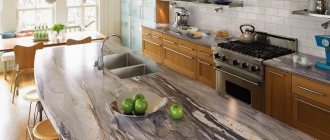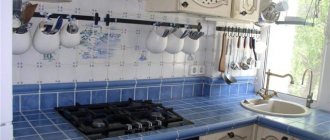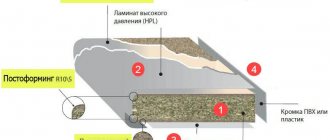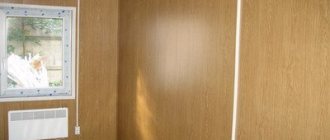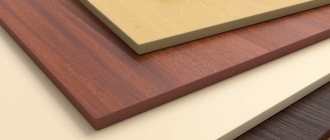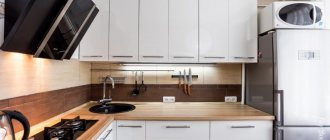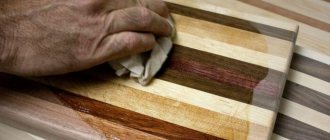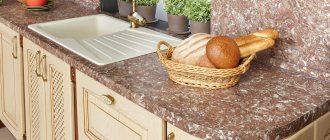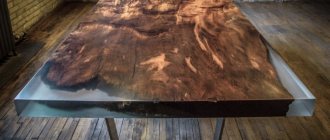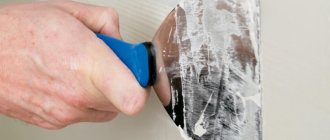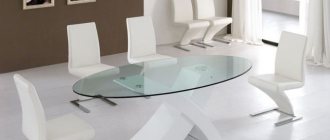Due to the specific nature of their task, kitchen countertops are subject to intense wear and tear. They are affected by moisture, steam, and temperature changes. A countertop is a work surface on which food is cut, meat is beaten and hot pots are placed. All this leads to damage. Tabletops made of laminated chipboard wear out especially quickly.
If signs of wear appear on the surface of the kitchen table, it is not necessary to look for a replacement countertop. In most cases, repairing the damage is cheaper than buying new furniture. Moreover, it is possible to repair a chipboard product with your own hands. How to do this - read on.
How to remove scratches and dents from furniture
For these purposes, there are both professional and folk methods. The latter have an important nuance - before using them on a visible surface, you need to try the method on an inconspicuous area so as not to create even more problems.
Furniture touch
Used to mask small scratches. It is a tube that is closed with a cap with a brush, like nail polish. Apply in one or several layers until the defect is completely eliminated. Excess is removed with the edge of a plastic card, and the surface itself is polished with felt or a soft cloth. It is difficult to choose the ideal color, so you can fill in the missing texture with a regular felt-tip pen and cover it with furniture varnish. For this purpose, it is better to use spray varnish. It is applied evenly and does not leave a visible edge of the composition.
Furniture wax
Can be soft or hard. The first one has many more colors, and it is easier to apply. But the hard one is more reliable in further use. It can be used for large dents or even chips. Soft furniture wax is easily warmed up with your fingers and applied in excess to the problem area. The excess can be easily removed with a plastic spatula. Then the surface is sanded and varnished with a composition with the appropriate degree of gloss.
Acrylate/acrylic putty
An option that is more suitable for deep dents. The putty is applied using a rubber or plastic spatula to the surface of the furniture, and after complete drying, it is sanded first with the finest sandpaper and then with felt. If the color does not match, the stain can be tinted with a marker or felt-tip pen, but it is better to take a composition one tone darker, because the light spot will stand out strongly against the general background.
stain
This is a universal composition for removing shallow scratches. The stain penetrates the structure of the wood, coloring it in the desired tone, but retains the texture of the wood, unlike paints and enamels, which give a solid, dense color. The stain should first be tested on an inconspicuous area of furniture, because... the shade may not match the one you want to see in the end. Take your time so that you are completely satisfied with the end result.
Walnut
This folk method is used in the presence of shallow scratches. The problem area is carefully treated with half a nut, and then sanded with a soft cloth to remove the oily sheen. Pecan nuts are also used for this. It should be clarified that this method will not help with deep unevenness; it only makes small scratches invisible that do not go deep into the structure. In addition, for dark wood, craftsmen suggest using a weak iodine solution. It will also help cover micro scratches. But remember that this masking will not even out the surface, but will simply visually hide the flaw.
Do-it-yourself removal of stains and small scratches from the surface of a stone
Don't be alarmed - the process will not take much time and will not require any special efforts or skills on your part. Repairing kitchen countertops made of artificial stone in the event of stains and minor scratches that cannot be removed with conventional means is simple:
- Gently sand the damaged area on the surface of the artificial stone with sandpaper with a maximum grit of P120, gradually reducing the sanding to a level of P400.
- Polish the countertop using a small piece of felt. The process will speed up significantly if you use a screwdriver or a sander with felt attachments.
- As a finishing treatment, you need to use a special polyester composition, having previously degreased the surface. You can consult with direct sellers of artificial stone and products made from them about the choice of finishing agent. As a rule, they offer for sale all the necessary accessories and caring and restorative compositions.
Repairing acrylic countertops with a thickness of artificial stone of about 3-6 mm and a base in the form of chipboard or MDF inside using grinding is not permissible! We are talking about sheet artificial stone from which countertops are made. The thickness of the material simply does not allow such a possibility - sanding off a stain or scratch. In this case, proceed as follows:
- Select a special adhesive for acrylic resin with a mineral filler according to the shade of the countertop.
- Using a hand cutter, carefully remove the damaged top layer of artificial stone.
- A “patch” of the required size is cut out of a material of similar quality and shade.
- The patch is carefully installed in the prepared place and glued.
- After the glue has completely dried (after about a day), the restored acrylic tabletop is polished with a felt cloth.
Repairing an acrylic countertop requires some skill. Therefore, it is better to invite a master.
Repairing chips and cracks on artificial stone countertops
Most of the typical defects on countertops made of artificial stone in the form of cracks and chips can be repaired on site. That is, there is no need to dismantle the kitchen work surface. Since the process itself will require some skill and the acquisition of a number of specific tools for acrylic restoration, it is better to invite a specialist for this. But if the volume of upcoming work does not frighten you, it is quite possible to carry out the repairs yourself. It will consist of the following stages:
- The area with damage (chips, deep scratches or cracks) is thoroughly cleaned of dirt and degreased. The cleaning process involves widening the chips by sanding the edges. There is no need to be afraid that the defect will become more noticeable.
- After cleaning the chips, the inside of the cracks is filled with a special composition of polyester resins, identical in shade to the quartz countertop being repaired. To “get into color” it is better to use restoration materials of the same brand and series.
- Next, the area to be restored is given time to completely dry and harden (this will require at least 18-20 hours). After this, the irregularities are sanded using abrasives. Final polishing is carried out using a grinding machine with a felt attachment.
Restoring and processing stone requires accuracy, diligence and a sense of proportion, which comes with experience. Since most of the work is carried out using power tools, you need to be able to “feel” the material. Otherwise, removing chips and cracks on a stone countertop yourself with your own hands can lead to the formation of even larger defects. Professionalism is also required in the preliminary assessment of the upcoming volume of restoration work. It is quite possible that it will not be possible to repair the working surface on site; dismantling and removal to a specially equipped workshop will be required.
Causes of cracks
During operation, force majeure cases often occur that can damage the horizontal surface. Although it is not uncommon for cracks to occur during the creation of furniture or when assembling parts. Another reason for the appearance of defects is the impact of moisture or temperature changes on the slab. Let us consider such cases in more detail.
When installing a tabletop, a crack may form in the places where the part itself is attached to the frame. The connection occurs by screwing self-tapping screws or bolts into the part. In this case, the screwing point may crack. This happens if the chipboard was of poor quality or the installer screwed the bolt or screw in incorrectly (twisted it at an angle, pressed it hard, etc.). Often, when cutting out a niche for a sink, chips and cracks occur.
Mechanical loads can also be the root cause of table damage. There is a risk of a crack forming if a heavy object falls on the table. In this case, in addition to cracks, other types of damage occur.
Changes in temperature and humidity in the room can deform the chipboard part, resulting in the surface cracking in some places. The area near the stove and sink is especially susceptible to this.
Restoration methods
There are several restoration methods. They are selected depending on the type of item, material and complexity of damage. First, study the condition of the furniture, carefully inspect every detail. If you have small scratches on the wood, they can be easily removed with wax chalk, which you can buy at a hardware or furniture store. For deep scratches you will need putty.
Minor furniture flaws can be eliminated quite easily:
If the facades have lost their shine and color, then a special product containing orange oil will help restore them to their original appearance. It needs to be rubbed in with a soft sponge, pre-moistened and heated. Remember safety - be sure to wear rubber gloves before starting work. Minor scuffs and stains can be easily removed with fresh banana peels. Wipe the stains and then use a dry, soft cloth to remove banana fibers. Whitish stains on the countertop can be removed with toothpaste. It should be applied to the stains, left for a couple of minutes, and then removed with a cloth. Minor scratches and abrasions can be removed with a construction marker.
But here it is important to choose the right color so that the painted spots do not stand out on the facades of the furniture. To make the marker look natural on the wood, blend it with a sponge or finger after application. Iodine is another effective remedy for removing small scratches.
True, iodine can only disguise them.
The listed methods are suitable for repair if the furniture is not seriously damaged and does not require complete restoration.
Restoring a varnished surface with your own hands
Working with a varnished surface is difficult. It is difficult to restore and most often requires complete removal of the varnish. But there are still several ways to repair minor damage:
- Small scratches are masked with a construction marker or iodine.
- Deep scratches can be removed with a masking mixture consisting of 3 parts turpentine and 4 parts melted wax. The resulting mixture is applied to the damage and rubbed in with a cloth.
- To repair scratches on dark-colored surfaces, try shoe polish. Use it to fill the damage and leave to harden, then buff with a soft cloth.
- You can remove stains with gasoline, alcohol, a mixture of alcohol and drying oil.
To restore the surface's shine, rub it with a mixture consisting of 1 part vinegar, 2 parts turpentine and linseed oil. The composition is applied with a swab for 30 minutes.
Veneer restoration
Restoration of veneered furniture is carried out using construction putty intended for repairing wooden surfaces. It is used to fill cracks and chips, and then the surface is painted. If there is a relief pattern, it is created before the putty hardens.
Swollen areas are eliminated using PVA glue. They need to fill the resulting bubble by piercing it with a needle. Then the working surface is covered with fabric, and a load is placed on top.
It is more difficult to work with veneer that has several damages, such as swelling and cracks. In this case, the furniture is restored in three stages:
- The swelling is filled with PVA glue.
- The cracks are filled with putty.
- After the putty has dried, the cracks are painted over with a marker or paint.
Tabletop restoration
The materials and tools we need for this depend on the material we will be working with.
Wood or chipboard
If the tabletop is made of wood or chipboard, then a special retouching felt-tip pen, furniture touch-up or tint wax will be suitable to eliminate scratches and cracks. It is first melted and only then applied, after which it is left to cool and dry.
To restore the surface you will need:
- hair dryer;
- waterproof sealant;
- a homogeneous thick mixture of sawdust and PVA glue;
- putty knife.
Using a retouching felt-tip pen
First, warm up the damaged area with a hairdryer.
- Apply sealant to the chipped area and leave it for 15 minutes.
- During this time, you need to make a mixture of sawdust and glue (5 minutes) and let it brew (10 minutes).
- Place the resulting mass on top of the sealant and compact it tightly, removing excess with a spatula.
- After this, saturate a microfiber cloth with a felt-tip pen of a suitable color and work it over the frozen composition, going beyond its edges.
- The result can be sealed with varnish. It will be especially good if you use a tint, it will additionally eliminate scuffs. In addition, it will be a salvation if you cannot find a felt-tip pen that perfectly matches the color of the surface.
Using wax
- First, the chipped area is ground with a chisel or sandpaper so as to level it as much as possible.
- After this, melted wax is applied to the place of the missing fragment.
Using film
Unfortunately, it is not always possible to return the previous look of the tabletop and make the added fragment “merge” with it. Therefore, the last option could be a special polymer film that imitates wood texture.
Plastic
Minor chips, scratches and cracks on the plastic surface are most often repaired with ordinary Moment glue. The fallen piece is attached back with the same glue.
However, it happens that when it falls, it is damaged so much that it loses its original appearance. In this case, it can be crushed, mixed with an adhesive composition and attached to the damaged area by analogy with wooden surfaces.
Fake diamond
Polyester resins are used to seal cracks on stone countertops. To do this, the surface is cleaned and degreased, and then filled with this material.
Then you just have to wait for it to harden. After a day, you can continue to use the countertop for its intended purpose.
If you need to restore the missing part, to do this, buy PVA glue, an acrylic repair composition suitable for the material, abrasives of different grain sizes and felt.
- The damaged area is sanded and polished.
- A reducing mixture is prepared.
- Having repaired the chipped area, leave it until completely dry (about 20 hours).
- After this it is sanded again and polished with felt.
Glass
But if chips, scratches or cracks appear on the glass surface of the tabletop, then this is the only case when you won’t be able to do it yourself.
It will be so difficult and expensive that it will be more profitable to buy a new countertop.
Advantages and disadvantages
The film allows you to completely renew the facades of furniture, and no special skills are required to work with it. Thanks to a huge selection of textures, colors, images, you can choose the right canvas for any interior of a bedroom, living room, hallway, nursery, office. The material has gained great popularity due to its advantages, among which are:
- Low cost. Decorating will cost several times less than purchasing new things.
- Interior renovation. With the help of the material you can often change the design of any room.
- Easy installation and dismantling. Anyone can carry out the work of applying and removing the canvas, without any additional tools.
- Easy cleaning. The surface can be cleaned using a regular sponge and water.
- Manifold. A large number of shades and textures makes the catalog products universal; they fit into any interior.
- Moisture resistance. The canvas does not allow water to pass through, it can even be used in the kitchen and bathroom, but it cannot withstand prolonged wetness.
- Resistance to household chemicals. For cleaning, you can use regular detergents.
- Resistant to temperature changes. The film is not afraid of either cold or heat, even sudden temperature changes.
Like any other material, self-adhesive products are not without disadvantages:
- Fragility. The service life of even the highest quality models does not exceed five years.
- Discoloration. Over time, under the influence of sunlight, the surface fades and loses its original appearance.
- Surface preparation. The base for pasting must be level, otherwise all defects and irregularities will be visible.
- Poor abrasion resistance. In places of active friction, the protective layer will be rubbed off.
How to restore a table edge?
To do this you need:
- Purchase a new melamine edge with glue of the desired shade and thickness (it is usually sold in strips in the same place where chipboard and furniture fittings are sold).
- Remove the old edge by heating the end with an iron.
- Sand the end using a chisel and sandpaper until the chips disappear.
Interesting materials:
How to correctly fill out a work book 2022? How to correctly fill out 6 personal income taxes for the first half of 2022? How to properly brew tea with ground ginger? How to brew flaxseed correctly? How to brew green tea in a teapot? How to properly certify work books 2022? How is Christmas celebrated in Germany? How to provide your services? How to pre-calculate your pension? How to convert GPT to MBR when installing Windows?
Principles and instructions for restoring chips on a countertop
Knowing how and what you can use to repair a chip or crack on a tabletop, it’s not difficult to repair the furniture structure yourself
At the same time, it is important to comply with technological requirements and use effective options for restoration compositions
Restoration of wood and laminated chipboard countertops
When solving the problem of how to repair a chip on a chipboard tabletop, repair work involves the following algorithm:
- use a hairdryer to warm up the damaged area;
- remove the exfoliated layer, clean the defect area;
- apply glue and leave for 15 minutes;
- prepare the restoring composition in the form of a homogeneous thick mixture of sawdust and PVA glue, leave for 10 minutes;
- the damaged area is sealed with the prepared mixture, the mixture is compacted with a spatula, and the excess is removed.
Restoring a wooden countertop takes at least 24 hours
At least 24 hours are required for complete drying, after which the repaired particle board material is ready for use.
To disguise scratches on a wooden countertop, you should sand the surface and sand it. At the final stage, felt is used to provide a glossy finish. To eliminate chips on a wooden base, mix sawdust and PVA glue and fill the voids, which are first cleaned, blow-dried and sanded.
Plastic countertop repair
Deciding how and with what to repair cracks and chips on a plastic countertop in the kitchen should depend on the complexity of the deformation:
- minor damage to the plastic surface can be repaired using superglue or Moment glue;
- in some cases, restoration of the working plane requires the use of special glue for plastic. The composition is applied using a gun;
- If a fragment of a plastic structure breaks off, Titan glue is used for restoration.
To restore chips, it is recommended to grind the plastic into crumbs or powder, mix well with Titan glue and repair the damaged areas of the structure.
Restoring an artificial stone countertop
Cracks and chips on the working surface made of artificial stone are repaired using polyester resins. The algorithm of restoration procedures includes the following manipulations:
- the damaged area is cleaned and degreased;
- if necessary, the chip site is slightly deepened and widened;
- seal the defects with polyester resin and leave to dry completely for a day.
Next, you need to sand the coating with fine sandpaper, followed by polishing with felt. Small scratches on artificial stone can be easily masked with a repair acrylic compound or a glossy solution. I’m planning how to remove a chip on a stone countertop in the kitchen, using PVA glue, abrasive material of different grain sizes and felt.
- prepare the surface by sanding and grinding the damaged areas;
- prepare a restorative composition from acrylic plastic with the addition of an adhesive mass to a thick, uniform consistency;
- The restoration mixture is used to seal the depressions, chips, cracks and leave until complete polymerization;
- Next, the coating is polished with an abrasive material; at the final stage, it is necessary to polish the surface with felt.
Restoring an artificial stone countertop
Stone countertops with minor defects are often repaired using a grinding machine.
To do this, at the first stage, grind and polish the base; this will help to easily eliminate traces of careless use of the working surface. Next, the material is treated with special reducing solutions. Then they go through the grinding unit again: first with an abrasive, and then with a polishing disc.
At the same time, small cracks and chips are eliminated, the stone base acquires an aesthetic appearance and presentability
Then they go through the grinding unit again: first with an abrasive, and then with a polishing disc. At the same time, small cracks and chips are eliminated, the stone base acquires an aesthetic appearance and presentability.
The nuances of glass countertop repair
A kitchen countertop made of glass is difficult to restore, so care and attention are required when using it. Special equipment is used to remove small scratches. This requires skill and skills in working with fragile materials.
If, as a result of careless handling, defects in the form of cracks or chips have formed on the surface, the structure will have to be replaced with a new one, since it will be difficult and expensive to restore the integrity of the glass tabletop
Preventive measures
The glass work surface of the original design attracts with its presentability and allows you to emphasize the status and originality of the interior solution. To prevent various damage to the fragile base, it is necessary to use special care products, and use convenient stands and mats for dishes.
Wood and chipboard countertops must be treated with silicone and moisture-resistant sealants to eliminate the risk of deformation under the influence of environmental humidity or direct contact with hot or cold liquids. It is also important to ensure that wooden structures are protected from fire, given the flammability of the material.
Update methods
How to update your kitchen countertops with your own hands? What are wood countertops in the kitchen covered with? Beginners have many questions and, as a result, difficulties in the restoration process, which plunge them into a stupor. Of course, any remodeling and restoration of kitchen furniture may ultimately not lead to the result that was originally planned. However, here you should remember that it’s never too late to get rid of your old table and buy a new one, but it’s still worth a try.
You can restore your kitchen table yourself or update it in the following ways.
- Painting through tulle involves painting the product with paint according to the stencil principle. To do this, the fabric is spread on the table in such a way that there are no tubercles. Next, you need to paint the entire surface using spray paint and let it dry, then remove the tulle. As a result, a beautiful lace pattern is formed on the table.
- Remodeling the table may involve restoration using ceramic tiles. This coating is not only attractive, but also practical, since it can withstand various types of influences. These can be whole blocks or multi-colored fragments in the form of a mosaic. If there are no tiles, glass shards can be used as restoration material.
- You can update an old table using self-adhesive film. Modern manufacturers offer inexpensive models with original designs. For restoration, it is enough to paste over the surfaces of the product - and it will be transformed before your eyes.
- If the table is made of solid wood, you can use the burning technique as an idea for restoration, but this requires certain work skills, as well as special equipment in the form of an electric burner.
- Decoupage is a very fashionable way to transform furniture and give it a completely different look. This does not require special artistic skills, because the basis is taken from ready-made photos on paper or a napkin, which are attached to the table.
Principles and instructions for restoring chips on a countertop
Knowing how and what you can use to repair a chip or crack on a tabletop, it’s not difficult to repair the furniture structure yourself
At the same time, it is important to comply with technological requirements and use effective options for restoration compositions
Restoration of wood and laminated chipboard countertops
When solving the problem of how to repair a chip on a chipboard tabletop, repair work involves the following algorithm:
- use a hairdryer to warm up the damaged area;
- remove the exfoliated layer, clean the defect area;
- apply glue and leave for 15 minutes;
- prepare the restoring composition in the form of a homogeneous thick mixture of sawdust and PVA glue, leave for 10 minutes;
- the damaged area is sealed with the prepared mixture, the mixture is compacted with a spatula, and the excess is removed.
Restoring a wood countertop takes at least 24 hours.
It takes at least 24 hours to completely dry, after which the repaired particleboard material is ready for use.
To disguise scratches on a wooden countertop, you should sand the surface and sand it. At the final stage, felt is used to provide a glossy finish. To eliminate chips on a wooden base, mix sawdust and PVA glue and fill the voids, which are first cleaned, blow-dried and sanded.
Plastic countertop repair
Deciding how and with what to repair cracks and chips on a plastic countertop in the kitchen should depend on the complexity of the deformation:
- minor damage to the plastic surface can be repaired using superglue or Moment glue;
- in some cases, restoration of the working plane requires the use of special glue for plastic. The composition is applied using a gun;
- If a fragment of a plastic structure breaks off, Titan glue is used for restoration.
To restore chips, it is recommended to grind the plastic into crumbs or powder, mix well with Titan glue and repair the damaged areas of the structure.
Restoring an artificial stone countertop
Cracks and chips on the working surface made of artificial stone are repaired using polyester resins. The algorithm of restoration procedures includes the following manipulations:
- the damaged area is cleaned and degreased;
- if necessary, the chip site is slightly deepened and widened;
- seal the defects with polyester resin and leave to dry completely for a day.
Next, you need to sand the coating with fine sandpaper, followed by polishing with felt. Small scratches on artificial stone can be easily masked with a repair acrylic compound or a glossy solution. I’m planning how to remove a chip on a stone countertop in the kitchen, using PVA glue, abrasive material of different grain sizes and felt.
- prepare the surface by sanding and grinding the damaged areas;
- prepare a restorative composition from acrylic plastic with the addition of an adhesive mass to a thick, uniform consistency;
- The restoration mixture is used to seal the depressions, chips, cracks and leave until complete polymerization;
- Next, the coating is polished with an abrasive material; at the final stage, it is necessary to polish the surface with felt.
Restoring an artificial stone countertop
Stone countertops with minor defects are often repaired using a grinding machine.
To do this, at the first stage, grind and polish the base; this will help to easily eliminate traces of careless use of the working surface. Next, the material is treated with special reducing solutions.
Then they go through the grinding unit again: first with an abrasive, and then with a polishing disc. At the same time, small cracks and chips are eliminated, the stone base acquires an aesthetic appearance and presentability.
The nuances of glass countertop repair
A kitchen countertop made of glass is difficult to restore, so care and attention are required when using it. Special equipment is used to remove small scratches. This requires skill and skills in working with fragile materials.
If, as a result of careless handling, defects in the form of cracks or chips have formed on the surface, the structure will have to be replaced with a new one, since it will be difficult and expensive to restore the integrity of the glass tabletop
Repair or change
Is it worth it to start repairing a laminated chipboard countertop yourself? To do this, you need to assess the degree of destruction. Sometimes it is not profitable to repair; it is easier to purchase a new laminated surface.
Often it is necessary to update only the surface layer by fixing a small fragment, and everything else can be left unchanged. Wood is one of the materials most suitable for repair; it is easy to extend and insert patches. In the case of laminated chipboard, everything is a little more complicated. Therefore, it is better to undertake repairs when the damage is small.
If the damage is small, then you can do your own restoration. Otherwise, you will need to replace a separate piece of the panel.
Helpful advice! It is problematic to repair built-in furniture and kitchen appliances. A good way to update is to replace just one wood countertop. Sometimes you have to change the entire facade, but this is cheaper than modernizing the entire kitchen.
It happens that the new surface contrasts with other planes of the kitchen unit, and it makes no sense to completely restore the original appearance of the kitchen. Then it is recommended to find a creative method, for example, cover the surface with a beautiful pattern, cover it with glass exactly to the size of the tabletop and seal the ends.
